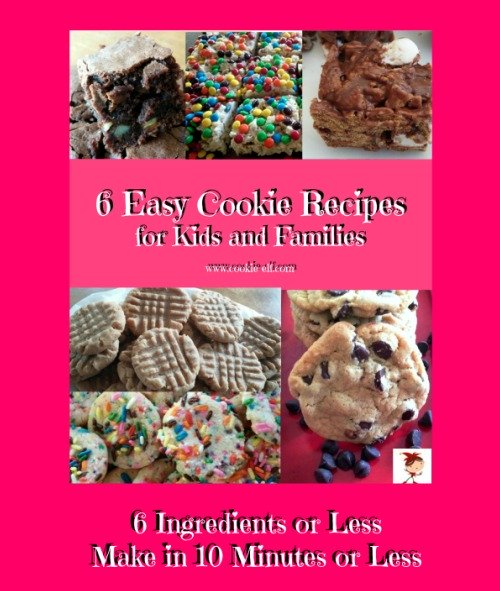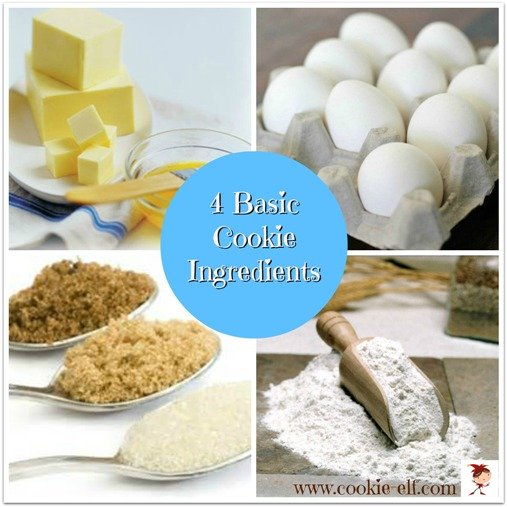Basic Cookie Ingredients in Cookie Dough
As you skim over cookie recipes, you discover that cookie ingredients can be classified into two groups: basic ingredients and additional ingredients.
Group #1: Basic Ingredients
Cookies contain four basic ingredients: fat, eggs, sugar, and flour.
Each cookie recipe is simply a variation of these four. Some cookie recipes have different amounts of each of these ingredients. Some incorporate one or more of the ingredients differently into the cookie dough.
Plus, each of these basic ingredients has variants, too. For instance, a cookie recipe may call for different kinds of fat, such as butter, oil, or even peanut butter. Or a recipe’s flour/dry ingredients can include oatmeal or cocoa powder.
These tweaks are what make each cookie recipe unique.
There are a few cookie recipes which are exceptions and do not include one of the basic four ingredients. For instance, gluten-free cookies do not contain flour or other grains with gluten. Rice Krispie Treats do not call for eggs. These trends off the norm provide variety in cookieology!
As you get to know these Big 4 you’ll gain a deeper understanding of how they behave in cookie dough and why their qualities impact a cookie’s flavor, appearance, and texture.
Group #2: Additional Ingredients
Beyond the Big 4, cookie recipes often include additional ingredients. These items can change the cookie’s flavor, texture, or character.
Leavens: baking powder, baking soda
Flavorings: spices, extracts (like vanilla, lemon, almond, and maple), and milk
Fillers: chocolate, flavored chips, dried fruits (such as raisins and dates), and nuts are just a few.
Toppings. Frosting, glaze, sprinkles, and decorations.
Another Way to Understand Cookie Ingredients
Ingredients in cookie recipes are wet and dry. Recipes follow science. An ingredient’s properties are part of that science.
Prior to the twentieth century, recipes were simply lists of items. In reading a recipe, it was assumed that you knew what to do with the ingredients.
Those assumptions are no longer part of the public’s collective knowledge. That’s why today’s cookie recipes give more detailed instructions. In most cookie recipes today, instructions call for wet and dry ingredients to be mixed together separately – and then the two are combined. The cookie recipe specifies in which order to combine ingredients.
Wet ingredients and dry ingredients have different properties and therefore play different roles in a cookie recipe.
Wet ingredients. Wet ingredients take more time to combine with others than dry ingredients. If you add dry at the same time as wet, you will have to over mix the dough to get the wet ingredients to incorporate into the dough. By adding dry ingredients to the wet mixture after it is combined, you help stabilize it.
Wet ingredients include fats (butter, margarine, oil, and peanut butter), eggs, liquid flavorings, milk, melted chocolate, and even melted marshmallows.
Dry ingredients. When over mixed, dry ingredients release chewy gluten strands leading to leathery, stringy texture. By adding dry ingredients to the combined wet ingredients, you allow all the ingredients to be dispersed evenly throughout the dough and produce an even, soft texture.
Dry ingredients are sugar, flour, leavens, spices, and fillers.
More about Cookie Ingredients in Cookie Recipes
4 Kinds of Cherries in Cookie Recipes ...
Candied Ginger: make your own for less ...
Caramel in cookies: sauce or candy ...
Milk chocolate in cookies: what makes it different ...
4 types of food coloring to use when making cookies ...
Nonpareils: the cookie decoration "with no equal" ...
Stevia in cookies: a no-calorie sugar substitute ...
Sugar in cookies: what it does and what kinds to use ...
Using oatmeal in cookie dough ...
More cookie ingredients on our Pinterest board ...
Return from Basic Cookie Ingredients in Cookie Dough to
The Cookie Elf home
Find A Cookie Recipe or Cookie Baking Tip
The Cookie Elf
FREE! 6 Easy Cookies Recipes for Kids and Families
Get your free copy here or when you fill in the form below.





New! Comments
Have your say about what you just read! Leave me a comment in the box below.